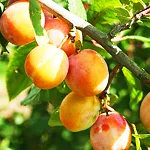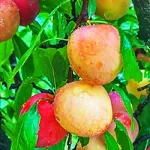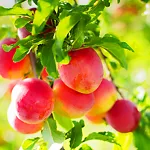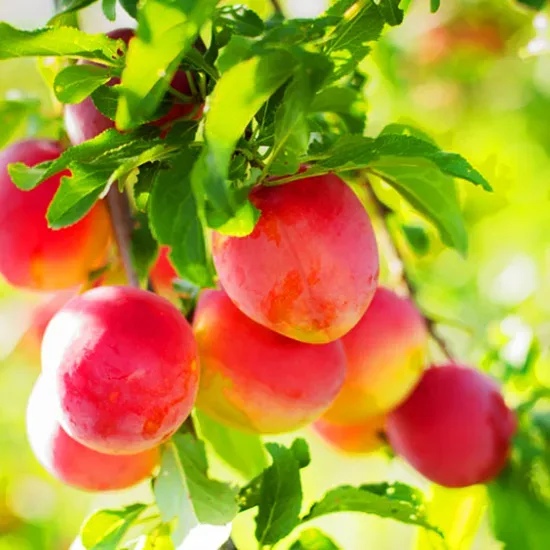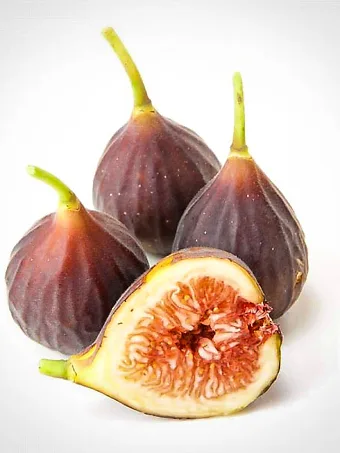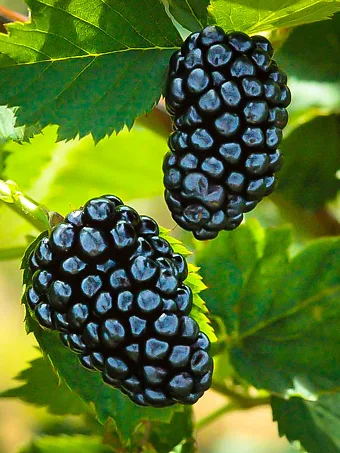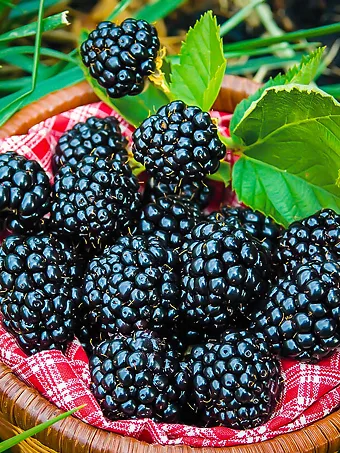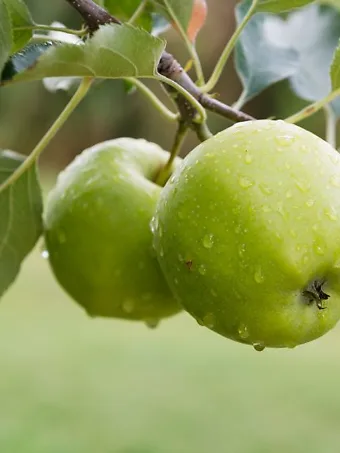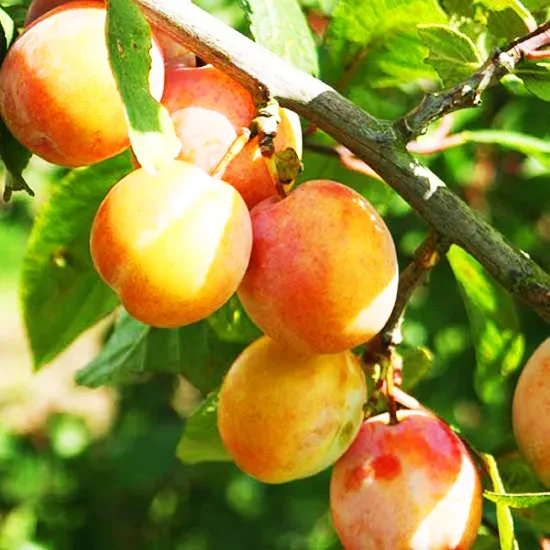
Burbank Plum Tree
Prunus salicina ‘Burbank'View more from Plum Trees
Burbank Plum Tree
Prunus salicina ‘Burbank'
30 day - ARRIVE AND THRIVE™ guaranteeLearn more


Special Features

Botanical Name
Prunus salicina ‘Burbank'
Outdoor Growing zone
5-9
Mature Height
10-20
Mature Width
10-20
Sun needs
Full Sun
The Burbank Plum Tree is an heirloom variety you must taste for its classic juiciness, firm flesh, rich sweetness and the perfect tangy balance. Within 2 to 4 seasons you will be harvesting big crops from mid-July into August, and this variety ripens over weeks, not all at once. The plums have yellow skin mostly covered in a red blush, with a little blue-white bloom, and rich yellow flesh. The tree is beautiful in bloom, with white blossoms on bare branches, and beautiful when the heavy crop bends the branches over for easy picking.
- Wonderful heirloom plums with a great taste
- Superb flavor, sweet, juicy and deliciously ‘plummy’
- Red and yellow skin with yellow flesh
- Grows well across a wide range of climates
- Ripens over several weeks starting in mid-July
Plant your Burbank Plum Tree in full sun to enjoy the biggest possible crop. It grows easily and rapidly in any well-drained soil, including acid or alkaline soils and sandy soil too. Pests or diseases are rarely serious issues, and some simple pruning – nothing fancy – is all it takes to enjoy weeks of fresh fruit right from your garden.
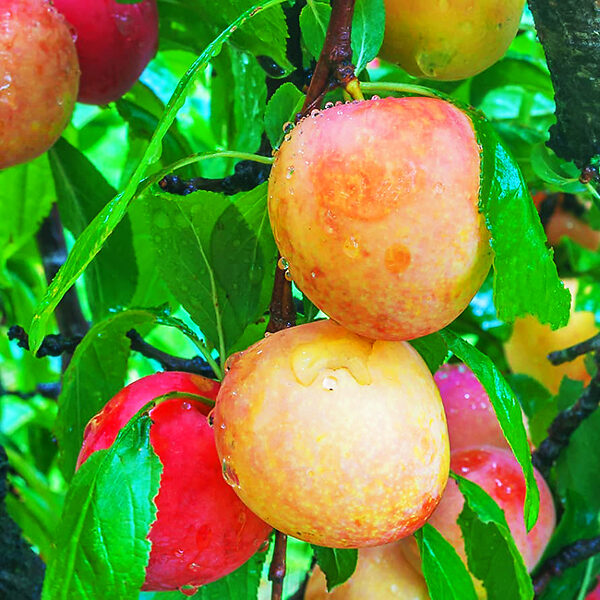
Sometimes the original is still the best, and you can certainly say that about the Burbank Plum Tree. This heirloom variety might be over 100 years old, but it carries a big crop of the best plums ever. Selected by the King of Fruit – Luther Burbank – from seedlings he brought over from Japan, this robust tree has plum shaded in delicate tones of yellow and red, with firm, juicy fresh that is sweet and just right for eating fresh. It ripens over several weeks, so no sudden excesses, with your precious harvest being wasted. It is the ultimate in multi-purpose, since it’s perfect for everything from fresh eating through baking and for preserves and jams that will see you through the winter with goodness. If you haven’t grown fruit trees before, this is a great place to start because it is fast-growing and needs no fancy pruning or care. Before more than a summer or two has passed you will be harvesting delicious home produce – how’s that sound?
Growing the Burbank Plum Tree
Size and Appearance
The Burbank Plum Tree is a deciduous tree that rapidly develops a rounded crown between 10 and 20 feet tall and wide. It can be kept on the smaller side with some summer pruning or left to make a great shade or specimen tree. The oval leaves are glossy and dark green, and early spring is a big deal, with beautiful pure white blossoms studding the bare branches, looking like a piece of Japanese art. It won’t be long before those blossoms are tiny green plums that grow rapidly, until by mid-July they will be big, plump and beginning to ripen. You will be harvesting over several weeks and the fruit stores well in the fridge, so it’s a long plum season with this tree. It is not self-fertile, so you do need to have another similar variety growing within 100 feet for it to set a good crop. Neighbors might have a suitable tree, or we recommend the Alderman Plum Tree, which ripens a little later, in August, extending the season even further. Other possibilities for partners are ‘AU-Rosa’, ‘Methley’ or ‘Santa Rosa’.
The plums are almost 2 inches long, turning from green first to yellow, and then developing a deep red blush all across them, leaving just some undertones of yellow on most fruits. There is a soft blue-white bloom on the fruit, giving it an artistic look. Polish it off or eat it – it doesn’t have any taste. The flesh is rich yellow, with a great firm texture, and very juicy. The flesh is sweet with a refreshing tang and a distinctive ‘Burbank’ taste you will love.
Using the Burbank Plum Tree in Your Garden
You can plant the Burbank Plum Tree anywhere in your garden – you certainly don’t need an orchard to enjoy home grown fruit. Plant it on a lawn as a specimen or small shade tree. Grow it behind your shrub beds, or on the sunny side of a wooded part of your property. Plant a screen of mixed fruit trees for an edible hedge that will keep you in fruit for months and months.
Hardiness
The Burbank Plum Tree needs just 400 hours of chilling, with temperatures below 45 degrees, so it will grow well in zone 9, through all the southern states except right along the Gulf or in Florida. It is also hardy all the way north into zone 5, so this national treasure can be grown across almost all of the nation.
Sun Exposure and Soil Conditions
Full sun is needed to get a good crop from the Burbank Plum Tree. Plant right out in the open, not under trees or in shade. It grows well in almost any soil, just as long as it is well-drained. Add some organic material when planting, to get it off to a good start. Within a couple of seasons it will be giving you fruit, and plan for a bumper harvest by season 4 at the latest.
Maintenance and Pruning
Although diseases and pests are possible, generally this vigorous tree will grow well with minimal problems. Some simple pruning after you finish picking your crop is all that is needed. Shorten back longer branches to keep the tree compact and remove any over-crowded limbs. Shorten all side-shoots longer than 12 inches back to 6 inches. Shorter branches don’t need trimming. If you want your crop mainly for eating fresh, thin out crowded clusters to leave a plum every 5 inches – these will be very large, very juicy and delicious.
History and Origin of the Burbank Plum Tree
Although called the Japanese plum, Prunus salicina actually came from China originally. The first plants in America were from Japan, which explains the name. They were brought over by Luther Burbank in the 1880s. Burbank is an American icon, and one of the greatest fruit breeders ever. Besides developing the nectarine as a new fruit he introduced and bred many varieties that set California on the path to being America’s fruit basket. He brought over a batch of seedling Japanese plums and grew them for a while, selecting the best, and using them to breed new hybrid varieties. Among those originals was a plant that stood out, and in 1897 the American Pomological Society honored Luther by officially introducing it with the name ‘Burbank’. After more than 130 years we still have that precious heirloom tree to enjoy.
Buying the Burbank Plum Tree at the Tree Center
If you love plums you can’t be without this great heirloom variety. Lovely to look at and delicious to eat, it’s a name that catches everyone’s attention. That is why we can never keep it in stock for long, so don’t miss this chance. Increasingly rare, this variety is not often available, so order now while we still have trees to ship you.
